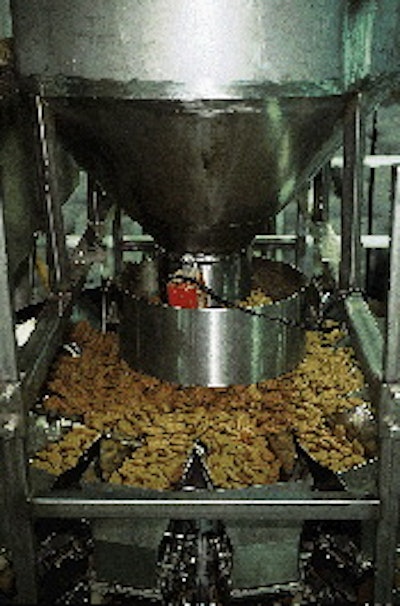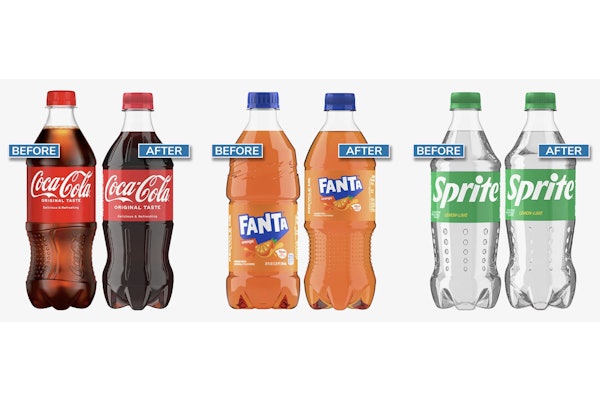In recent years, manufacturers have embraced the stand-up pouch for an increasing variety of products. Makers of dry pet foods, in particular, have nuzzled up to the flexible pack.
Northfield, MN-based Ryt-way Industries wanted to pounce on the purring pet food/pet treat market. "In the past, our focus has been in stand-up, reclosable zipper packaging for human food products," explains Tim Hickey, vice president of sales and marketing for the contract packager/private-label manufacturer.
"But we saw that one of the leading-edge technologies was formed, filled and sealed pouches for animal treats," he notes. "Because of that, we dedicated a facility for the production and storage of those products, totally separate from our human food operations."
That 18ꯠ sq' facility in Lakeville, MN, produces nothing but pet foods. Other Ryt-way plants in Minnesota pack products like microwave popcorn, snacks and other dry foods.
Ryt-way is so confident of its future in pet food packing that this summer it doubled the Lakeville plant's size to provide more storage space.
First North American user
At the heart of the Lakeville plant's packaging operation is an FBM (flat bag machine) 20 horizontal form/fill/seal machine made by Laudenberg Packaging Machinery in Germany. Laudenberg is represented in the U.S. by Profile Packaging (Sarasota, FL). A Profile representative says Ryt-way is the first company in North America to use the machine.
Added in mid-'97, the FBM 20 produces about 15 different SKUs, for product sizes ranging from 6 oz to 2 lb. The contract packager says the machine produces stand-up, zippered pouches up to 113/4" W x 133/4" H. Ryt-way runs the machine at 30 to 60 pouches/min, depending on bag size and product density, although the equipment is rated to function at higher speeds.
"We purchased the machine because it was exactly what we needed for some of the products we were working with," explains Tom Chlan, maintenance manager. When the Lakeville plant opened in '95, Ryt-way used it as both a warehouse and to pack pet food on two hf/f/s machines and one vertical f/f/s unit. All three machines continue to function admirably for Ryt-way, with the vf/f/s operating next to the Laudenberg. The two older hf/f/s units were relocated to a separate Ryt-way plant that packs food products.
'Stand-up' customer
According to Hickey, when the FBM 20 was purchased it was the only machine that could produce a pouch large enough for Hill's Pet Nutrition's 2-lb pet treats. Hill's was the first customer to market packs made on the Laudenberg machine. The FBM 20 produces resealable, stand-up pouches containing either 1- or 2-lb quantities of Hill's Science Diet® Treats for dogs, as well as a variety of pet foods and treats that Hill's exports. The machinery was producing export products at the time of PW's visit.
Topeka, KS-based Hill's, a maker of premium dog and cat food, markets its products through specialty retail pet stores and veterinary offices, but not through supermarkets or mass merchandisers. Its Science Diet Treats were introduced in late '93, packed in composite canisters. Several factors led Hill's to make the switch to the flexible pouch in mid-'97.
"We were in one size, a five-hundred-gram container," explains John Munchoff, group marketing director for the Hill's Science Diet line. "We knew different households had different size needs so we came out with a one- and two-pound size, as well as a four-ounce trial size that offers consumers a low-cost way to try the product." The 1- and 2-lb pouches offer resealable zippers and are filled on the FBM 20; the 4-oz pillow pack sample size is filled on the vf/f/s unit and is not resealable.
Steve Vogel, a senior packaging engineer for Hill's, adds, "We were restricted height-wise and in diameter by the canister. We were in a five-inch-diameter can already; so any larger diameter would have been hard for the consumer to grip. And all the equipment in our plant was restricted to an eight-inch canister height, so we couldn't go any taller," he points out.
Another reason for the change to the pouch, Munchoff says, "was from an image point of view. The graphics on the plastic film are far superior to what we were able to get before," he explains. "There is also more space on the pouch for graphics than there was on the canister. And there's more flexibility for stores to market the pouch because it can be sold on the shelf, on hooks, or on clip strips."
Adding new sizes and using graphics to its advantage were especially important to Hill's, Munchoff notes, "because of the different nutrition formulations we offer for each stage of a pet's life. There's a product for puppies, one for adults, one for seniors, one for those prone to gain weight and so on."
Hill's was conscious of competitive pet treat products moving to resealable pouches in the past few years. Still, the decision to switch to the pouches had to be economically justified. It was. "The pouch is significantly less expensive," Vogel contends. "And that was one of the drivers for the change."
The decision to use Ryt-way was based on Hill's careful evaluation of the contract packager. "We hadn't worked with them in the past," says Vogel. "But we did our homework and learned that they'd been in the contract packaging business for more than twenty years. We took a tour and investigated their operation, and we found out that they had done some work in packing pet food and were looking to expand that part of their business. They have all the quality assurance systems, operations personnel and equipment to do a good job for us and we've built a relationship with them."
Reliable film
At Ryt-way, the Laudenberg machine isn't the only new piece of equipment on the line. Downstream, a robotic case packer and a case erector help automate that process (see sidebar below).
At the front end of the line, the contract packager typically receives pet food from Hill's in huge shipping sacks that are emptied into a hopper. Product discharges at the bottom of the hopper, passing over a vibratory feeder that screens out broken pieces and fines. Treats are carried on a Meyer Machine (San Antonio, TX) bucket elevator to a 16-head Hayssen/Yamato Dataweigh computer combination weighing system from Hayssen (Duncan, SC).
A combination of scale buckets that together provide the most accurate weighment then releases the treats through the machine's forming collar into the opened pouch, made of film converted by Printpack (Atlanta, GA).
Hill's wouldn't describe the specific layers of the structure other than to say it's a 5.5-mil, three-ply coextrusion. Its outer polyester ply is reverse-printed flexographically in five colors by Printpack.
"It's not a complex structure," Hill's Vogel says of the film. "But its core ply provides strength and rigidity. Its inner sealant offers excellent hot tack and good adhesion for the heat-sealed zipper. It's also compatible with the product." The treats, he says, require some control of moisture loss, though there are no extraordinary barrier needs. Gas flushing is unnecessary, PW is told.
Initial machine functions
The film unwinds through tensioning rollers and past a hole-punch station where two holes are punched in what will later become the corners of the bottom gusset. A servo motor-driven feed roller drives the film and maintains proper film registration.
As the film unwinds, a Videojet Systems Intl. (Wood Dale, IL) Excel ink-jet coder applies two lines of copy to the back panel. The top line is a "Best Before" date. The bottom includes a Julian date, lot code and production shift number.
The film continues through another set of tensioning rollers before reaching the forming plow. Unlike many hf/f/s systems where the plow remains stationary, the FBM 20's plow moves back and forth as the flat film folds in half vertically. The bottom area is pushed up into the folded film, with the two hole-punched areas aligned and sealed together at the two bottom edges.
Next, the zipper material unwinds on a horizontal plane. The low-density polyethylene zipper is supplied by Presto Products (Appleton, WI). The zipper material opens as it contacts a guide plate. A sealing bar mounted to both sides of the guide plate heat-seals one half of the zipper to each of the two inner film sides.
The zipper material is then crush-sealed at both side edges before the film continues through two more heat-sealing stations that seal what become the sides of the packs. The bottom corners are then heat-sealed, resulting in a stand-up, flat-bottom gusseted pouch. Afterward, a cut-off knife cuts through the vertical side seal, separating the leading pouch from the web. A photoeye mounted at the cut-off area helps maintain film registration. Located near the cut-off is a second servo-driven motor that works in conjunction with its upstream cousin to move the film through the machine.
Filling turret steps
Transfer clamps grab the sealed pouch, holding it as it traverses the eight-station filling turret. At the first station, bag clamps hold the pouch. The pouch is opened at the next station by vacuum, with a blast of air blown down into the pouch to facilitate spreading. An air cylinder with two spring-loaded levers descends into the open pouch. The levers open near the bottom of the pouch. If the levers detect that the bag is not fully open, or if there is no bag, a no-fill signal will be sent to the next station.
The fourth station is filling. Here, a duckbill moves down into the pouch. The Hayssen/Yamato system usually empties five or six buckets to maximize fill accuracy, according to Ryt-way's Tom Chlan.
Ryt-way uses two vacuum tubes that draw in dust or tiny product particles called fines. One tube works at the filling station, the second just before top sealing.
Next, a mechanical device is inserted into the filled pouch to help settle the product. That's followed by two clamping mechanisms that squeeze the zipper shut. Heat-sealing of the top edge of the pouch is done at station seven before a clamp picks off the filled and sealed pouch at station eight, transferring it onto a discharge conveyor leading to downstream packing steps.
Mutual satisfaction
The line, says Hickey, has the capacity to produce about 10 million packs/yr. Ryt-way runs two shifts/day, five days/week. While the company wouldn't reveal specific volumes, Hickey says that he anticipates an equipment payback in less than two years. That return on investment expectation, along with doubling the size of the Lakeville plant, would seem to indicate that Ryt-way wasn't barking up the wrong tree with its decision to pack pet edibles.
Yet, those advantages would go for naught if customers were unhappy. Especially Hill's, which is Ryt-way's largest-volume pet food customer. After a little more than one year in the stand-up pouch, Hill's couldn't be more delighted.
"Rarely do you receive a call saying you've done a good job introducing a new package," explains Munchoff of Hill's. "But we believe our customers are very happy with the pouch, and the additional sizes we've been able to offer to better meet their needs," he continues. "And I think anytime you bring something new to the [retail] trade, be it a new package or product, it's something that they believe they can use to energize their customers."
Munchoff explains, "We are very pleased with the way our sales have responded since we introduced this package. It has potential [for other sizes as well], and it gives us the same one-year shelf life we had before. And the savings we've achieved with the plastic packaging we've passed along to the consumer."
Ryt-way's success with the machine led to its purchase of a second FBM 20 in June. The latest machine was installed in a separate plant where it's been used to fill a variety of products including snacks, pasta, croutons and cough drops.

































